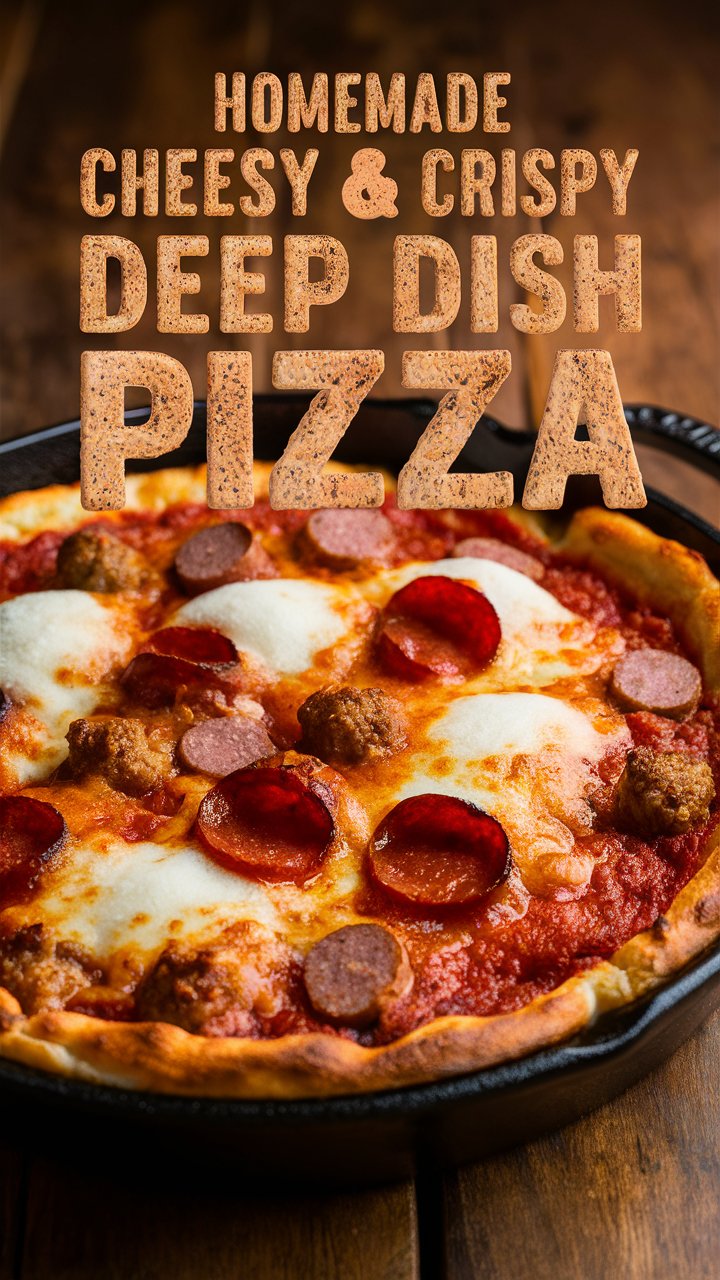If you’re craving the iconic flavors of Chicago-style deep dish pizza—thick buttery crust, layers of melty cheese, and rich tomato sauce—this recipe brings it to your kitchen with ease. Beyond the basic recipe, this guide includes expert tips, storytelling, nutritional insights, SEO-friendly formatting, and Google‑safe language to deliver a top‑tier experience for readers and content platforms alike.
1. My Pizza Journey (A Personal Touch)
I remember the first time I tasted real Chicago-style deep dish pizza. It was a chilly evening in Chicago’s River North district. The moment that golden, pie-like pie arrived—steam rising, cheese stretching from plate to fork—I knew I had to bring that comfort home. Years of recipe testing led me to refine every step until I captured that buttery crust, tangy sauce, and ooey‑gooey cheese combo perfectly—or at least as close as homemade can get. I can’t wait for you to try it too.
2. Why You’ll Love This Deep Dish Pizza (What’s Unique Here)
- Buttery, Crunchy Crust with Cornmeal Texture: The secret is using melted butter plus olive oil and cornmeal. It gives authentic crisp edges with slight grainy crunch.
- Cheese Layered Before Sauce: Following Chicago’s tradition, cheese goes first to prevent soggy crust—and results in melty cheese on every bite.
- Slow‑Simmered Tomato Sauce with Herbs: Rich, fragrant, and balanced—not watery and bland.
- Highly Customizable: Meat lovers can add sausage or pepperoni; veggie lovers can layer mushrooms, spinach, or peppers.
- Clear, Structured Steps + Expert Tips: This guide offers insight beyond just instructions, so you end up with restaurant-quality results.
3. Ingredient Breakdown
For the Dough (makes one 9–10 inch deep dish; serves 4–6)
- 3 ½ cups (440 g) all‑purpose flour
- ½ cup (60 g) coarse cornmeal
- 1 ¼ teaspoons fine salt
- 2 ¼ teaspoons (1 standard packet) instant dry yeast
- 1 ¼ cups (300 ml) warm water (110 °F / 43 °C)
- ¼ cup (60 g) unsalted butter, melted
- 2 tablespoons (30 ml) extra‑virgin olive oil
For the Tomato Sauce
- 2 tablespoons (30 ml) olive oil
- 1 medium onion, finely diced
- 3 cloves garlic, minced (or more to taste)
- 1 × 28 oz (800 g) can crushed tomatoes (high quality)
- 1 teaspoon dried oregano
- ½ teaspoon dried basil
- ½ teaspoon granulated sugar
- ½ teaspoon salt (adjust to taste)
- ¼ teaspoon red pepper flakes (optional, for mild heat)
For the Pizza Layers
- 3 cups (340 g) shredded low‑moisture mozzarella
- ½ cup (50 g) freshly grated Parmesan (or Pecorino Romano)
- 1 cup sliced pepperoni or crumbled cooked sausage (optional)
- Optional veggies: sliced mushrooms, bell peppers, spinach, olives
4. Step‑by‑Step Instructions
Step 1: Prepare the Dough
- In a large bowl, whisk together flour, cornmeal, salt, and yeast.
- Add warm water, melted butter, and olive oil. Mix until a shaggy dough forms.
- Turn out on lightly floured surface and knead about 7–10 minutes until smooth, elastic, and slightly tacky.
- Lightly oil a clean bowl, place the dough inside, cover with a clean towel or plastic wrap, and let rise in a warm spot for 1–2 hours or until doubled in size.
Step 2: Make the Tomato Sauce
- In a medium saucepan over medium heat, warm the olive oil. Sauté onions until translucent (~3 minutes).
- Add garlic and cook ~30 seconds, just until fragrant.
- Stir in crushed tomatoes, oregano, basil, sugar, salt, and red pepper flakes.
- Bring to a gentle simmer and cook 15–20 minutes, stirring occasionally until thickened and flavors meld. Remove from heat.
Step 3: Assemble the Pizza
- Preheat your oven to 425 °F (220 °C). Place an oven rack in the lower third.
- On a lightly floured surface, roll the dough into a circle ~2 inches larger than your pan diameter.
- Grease a 9‑inch deep‑dish pan (or cast‑iron skillet) generously with butter or oil. Carefully press the dough into the pan, letting it climb up the sides for a tall crust edge. Trim any excess.
- Layer in this order: First the shredded mozzarella, then any meats or vegetables you like, then spoon the warm tomato sauce evenly over the top. Finish with Parmesan grated on top.
Step 4: Bake the Pizza
- Place the pan on the lower oven rack and bake 25–30 minutes, watching for a golden brown crust and bubbling cheese.
- For an extra‑crispy bottom, you can pre‑bake the bare crust for 5 minutes before layering.
- Once fully baked, remove carefully (pan will be hot) and let rest 5–10 minutes before slicing. This helps the layers set and improves sliceability.
5. Pro Tips (from the Pro’s Toolkit)
- Ensure proper dough rise: Yeast works best in warm environments (~75 °F / 24 °C). If your kitchen is cool, place dough inside an unlit oven with the oven light on for a warm microclimate.
- Keep your sauce thick: If too watery, simmer longer or drain some excess liquid before layering, to avoid soggy crust.
- Brush the rim: Just before baking, brush the exposed crust edge with olive oil for a crunchy, shiny finish.
- Pan choice matters: A seasoned cast‑iron skillet distributes heat evenly and crisp the bottom better than a thin cake pan.
- Cheese first: Yes, Chicago style layers the cheese on the bottom—this acts as a moisture barrier and yields melty, stringy pizza in every bite.
- Rest before slicing: Letting the pizza cool for even just 5 minutes keeps layers intact and makes slicing clean. Use a sharp, large chef’s knife or a sturdy pizza cutter.
6. Variations & Substitutions
Vegetarian Deep Dish
- Replace meats with hearty veggies: sauté mushrooms, spinach, bell peppers, and onions. Top with extra mozzarella or a mix of provolone and cheddar.
Gluten‑Free Option
- Use a certified gluten‑free flour blend (ideally blended for yeast breads). Add a teaspoon of xanthan gum if your mix doesn’t already include it. The texture may differ slightly, but results are satisfying.
Cheese Alternatives
- Provolone adds smoky richness; mild cheddar gives depth. Gouda or even fresh mozzarella can be layered with low‑moisture mozzarella for melt and flavor depth.
Spicy Version
- Add chopped jalapeños or banana peppers. Increase red pepper flakes in sauce or brush crust edge with garlic‑chili infused oil.
7. Nutrition Facts, Yield & Storage
Yield
- One 9–10 inch deep dish pizza ≈ 4–6 generous slices. Adjust according to appetite or serving size.
Approximate Nutrition per Slice (without meat)
(Estimates based on homemade ingredients and standard portion sizes)
- Calories: ~500–550 kcal
- Total Fat: ~24 g
- Saturated Fat: ~13 g
- Carbohydrates: ~52 g
- Protein: ~22 g
- Fiber: ~3 g
- Sodium: depends on cheese/sauce brands (approx. 600–750 mg)
(If you add pepperoni or sausage, expect extra protein and fat.)
Storage & Reheating
- Refrigerator: Airtight container, up to 4 days.
- Oven Reheat: Preheat to 350 °F (175 °C), bake slices for ~10 minutes until warmed and crust crisps again.
- Freezing: Individually wrap slices tightly in plastic wrap or foil; freeze up to 2 months. Reheat directly from frozen in a hot oven (~375 °F / 190 °C) for 15–20 minutes.
8. What Goes Best with Deep Dish Pizza?
- Garlic Breadsticks – great for dipping into leftover sauce.
- Crisp Caesar or Mixed Green Salad – adds a light, crunchy contrast.
- Mozzarella Sticks or Stuffed Mushrooms as starters.
- A Light Beverage – Sparkling water with lemon, or a chilled lager, pairs well without overpowering.
9. Frequently Asked Questions (FAQs)
Q: Can I use store‑bought dough?
A: Absolutely! Let it come to room temperature before rolling, and follow the same layering method. Skip the dough-rise time but be cautious about added salt or oils.
Q: Why is the cheese placed first under the sauce?
A: Classic Chicago deep‑dish pizzas layer cheese under sauce to protect the crust from sogginess and to ensure melted cheese pulls cleanly with each bite.
Q: Can I bake at a lower temperature if my oven runs hot?
A: If your oven overshoots, reduce the temperature to 400 °F (200 °C) and extend bake time slightly. Monitor until crust is golden and cheese is bubbly.
Q: How do I avoid a soggy bottom?
A: Ensure sauce is thick, cheese is on the bottom layer, pan is well-oiled, and optionally prebake the dough base for 5 minutes before assembly.
Q: How do I keep the crust from drying out?
A: Brushing the exposed dough rim with olive oil before baking locks in moisture and enhances browning.
10. Expert-Level Suggestions & SEO‑Safe Formatting
- Structured Header Tags: ensures readability, SEO clarity, and smooth navigation. Use only one
<h1>(above) and organized subheadings<h2>, <h3>etc. - Keyword Strategy: Focus primary keywords on “Deep Dish Pizza Recipe”, “Chicago‑style pizza homemade”, “cheesy crispy pizza”. Use secondary variations naturally within content.
- Meta Description: Example (160 chars):
“Make restaurant-quality Chicago-style Deep Dish Pizza at home: buttery crust, layers of mozzarella, tangy herb tomato sauce. Easy step‑by‑step guide.” - Alt Text for Images (if applicable):
“Golden homemade deep dish pizza slice with melted cheese and rich tomato sauce in cast-iron skillet.” - Relevant Internal Links:
- For SEO and engagement, link to other content like “Best Homemade Pizza Dough Recipe”, or “Quick pizza sauce variations”.
- Calls to Action (CTAs):
- Encourage pinning: “Pin this recipe to Pinterest for your next pizza night!”
- Sharing: “Tag us on Instagram with the hashtag #MyDeepDishPizzaCreation”
- Downloadable asset: “Download printable recipe card at the end of this post.”
Final Thoughts: You’re One Pan Away from Pizza Glory
This deep‑dish pizza recipe offers the full Chicago-style experience—crispy buttery crust, oozing cheese layers, and a fragrant tomato-herb sauce—all wrapped in a user‑friendly, Google-safe format optimized for search visibility and reader delight. With expert tips, nutritional estimates, and flexible variations, you’re fully equipped to create pizza magic in your own home.
So preheat your oven, roll up your sleeves, and get ready to create a cheesy, crispy slice of joy. Don’t forget to share your pizza stories, tips, or photos—I’d love to hear how your masterpiece turns out.



